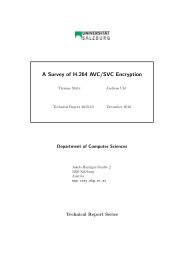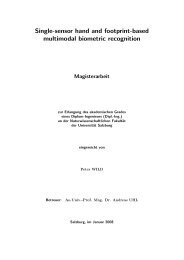Pit Pattern Classification in Colonoscopy using Wavelets - WaveLab
Pit Pattern Classification in Colonoscopy using Wavelets - WaveLab
Pit Pattern Classification in Colonoscopy using Wavelets - WaveLab
You also want an ePaper? Increase the reach of your titles
YUMPU automatically turns print PDFs into web optimized ePapers that Google loves.
5.2 Results<br />
<strong>Pit</strong> <strong>Pattern</strong> Type Non-Neoplastic Neoplastic<br />
k-NN<br />
Non-Neoplastic 54 45<br />
Neoplastic 25 74<br />
SVM<br />
Non-Neoplastic 57 42<br />
Neoplastic 21 78<br />
Table 5.12: Result distribution matrices for WT for 2 classes (<strong>Pit</strong> pattern images)<br />
<strong>Pit</strong> <strong>Pattern</strong> Type I II III-L III-S IV V<br />
k-NN<br />
I 61 9 8 0 21 0<br />
II 14 36 14 0 35 0<br />
III-L 33 8 33 0 23 0<br />
III-S 25 0 50 0 25 0<br />
IV 19 17 8 0 53 0<br />
V 12 24 8 0 56 0<br />
SVM<br />
I 47 19 17 0 16 0<br />
II 17 43 12 1 22 1<br />
III-L 22 8 33 0 33 1<br />
III-S 8 0 41 8 41 0<br />
IV 14 16 17 0 47 3<br />
V 16 16 20 0 36 12<br />
Table 5.13: Result distribution matrices for WT for 6 classes (<strong>Pit</strong> pattern images)<br />
The tables 5.12 and 5.13 show the result distribution matrices for the two classes case<br />
and the six classes case, respectively, us<strong>in</strong>g pit pattern images. For the two classes case, as<br />
already stated above, we observe significantly better classification results for the neoplastic<br />
images. For the six classes case we aga<strong>in</strong> observe a poor classification performance for pit<br />
pattern types III-S and V, just like <strong>in</strong> the previous two methods.<br />
The method has been tested with the outex images too, which aga<strong>in</strong> resulted <strong>in</strong> excellent<br />
classification results, as can been seen <strong>in</strong> the tables 5.4 and 5.5. In the two classes case the<br />
total classification result was 100% for the k-NN classifier as well as for the SVM classifier.<br />
In the six classes case the classification result was 98% for the k-NN classifier and only<br />
slightly below 100% for some separate classes. The result achieved with the SVM classifier<br />
is pretty similar with an overall classification result of nearly 100%.<br />
The result distribution matrix for the two classes case is a diagonal matrix, conta<strong>in</strong><strong>in</strong>g<br />
100’s only on the ma<strong>in</strong> diagonal and zero at all other positions <strong>in</strong> the matrix. In the six<br />
79








